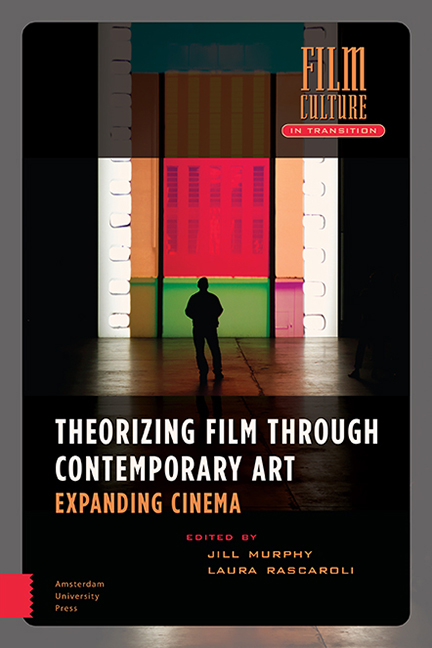Book contents
- Frontmater
- Dedication
- Contents
- List of Illustrations
- Acknowledgments
- Foreword: Courtesy of the Artists
- Introduction: On Cinema Expanding
- Part One Materialities
- 1 Cinema as (In)Visible Object; Looking, Making, and Remaking
- 2 Objects in Time; Artefacts in Artists’ Moving Image
- 3 Materializing the Body of the Actor; Labour, Memory, and Storage
- 4 How to Spell ‘Film’; Gibson + Recoder’s Alphabet of Projection
- Part Two Immaterialities
- 5 The Magic of Shadows; Distancing and Exposure in William Kentridge’s More Sweetly Play the Dance
- 6 Douglas Gordon and the Gallery of the Mind
- 7 A Throw of the Dice Will Never Abolish Chance; Tacita Dean’s Section Cinema (Homage to Marcel Broodthaers)
- Part Three Temporalities
- 8 The Photo-Filmic Diorama
- 9 The Cinematic Dispositif and Its Ghost; Sugimoto’s Theaters
- 10 Time/Frame: On Cinematic Duration
- Part Four The Futures of the Image
- 11 Interactivity without Control; David OReilly’s Everything (2017) and the Representation of Totality
- 12 Post-Cinematic Unframing
- 13 Absolute Immanence
- Index
5 - The Magic of Shadows; Distancing and Exposure in William Kentridge’s More Sweetly Play the Dance
Published online by Cambridge University Press: 23 June 2021
- Frontmater
- Dedication
- Contents
- List of Illustrations
- Acknowledgments
- Foreword: Courtesy of the Artists
- Introduction: On Cinema Expanding
- Part One Materialities
- 1 Cinema as (In)Visible Object; Looking, Making, and Remaking
- 2 Objects in Time; Artefacts in Artists’ Moving Image
- 3 Materializing the Body of the Actor; Labour, Memory, and Storage
- 4 How to Spell ‘Film’; Gibson + Recoder’s Alphabet of Projection
- Part Two Immaterialities
- 5 The Magic of Shadows; Distancing and Exposure in William Kentridge’s More Sweetly Play the Dance
- 6 Douglas Gordon and the Gallery of the Mind
- 7 A Throw of the Dice Will Never Abolish Chance; Tacita Dean’s Section Cinema (Homage to Marcel Broodthaers)
- Part Three Temporalities
- 8 The Photo-Filmic Diorama
- 9 The Cinematic Dispositif and Its Ghost; Sugimoto’s Theaters
- 10 Time/Frame: On Cinematic Duration
- Part Four The Futures of the Image
- 11 Interactivity without Control; David OReilly’s Everything (2017) and the Representation of Totality
- 12 Post-Cinematic Unframing
- 13 Absolute Immanence
- Index
Summary
Abstract
This chapter examines how William Kentridge develops his investigation of Plato's allegory in More Sweetly Play the Dance (2015), unravelling it and testing the limits of his commitment to it. It is proposed that Kentridge's use of pre-cinematic techniques to conceal the image and keep it at a distance reflects Jean-Luc Nancy's understanding of the image as distanced and separate. Nancean thinking can work in conjunction with the artist's imagery and conceptual logic because it considers the personal and corporeal in conjunction with community and commonality, in other words, how we coexist in the world. The Nancean singular plural is visualised in Kentridge's winding procession in which singular and plural coexist in a spaced intimacy.
Keywords: Shadow play, Plato's cave, Jean-Luc Nancy, distancing, exposure
The magic and illusion involved in the creation of an image – moving or otherwise – is central to William Kentridge's work. Whether making a charcoal stroke or employing rudimentary animation and projection, Kentridge locates himself within the earliest forms of both mark-making and the moving image. Conceptually, much of his later work takes as its starting point Plato's allegory of the cave dwellers in conjunction with the ancient form of the procession. Lateral images of the procession date back to lines of beasts moving linearly across the caves of Lascaux and Chauvet, progressing, via Goya's processional paintings – which Kentridge cites as an influence – to contemporary images of lines of displaced people, travelling on foot to escape famine, oppression, or war. As Kentridge observes, ‘[t]he image of a procession of people pulling or carrying their baggage is both a contemporary and immediate image and one deeply rooted in our psyches’. His use of primitive forms creates a continuum, a sort of Benjaminian now-time, as Huyssen suggests, that links, via the procession, the ancient art of shadow puppetry and the allegory of the cave – both dating back to the pre-Christian era – to pre-cinematic attempts to project and animate an image and to the magical illusion of early cinema. In this chapter, drawing on these elements in tandem with Jean-Luc Nancy's ideas on the image and the singular plural, I focus on the processional imagery of Kentridge's 2015 video installation More Sweetly Play the Dance and the distancing and exposure it evokes.
- Type
- Chapter
- Information
- Theorizing Film Through Contemporary ArtExpanding Cinema, pp. 123 - 142Publisher: Amsterdam University PressPrint publication year: 2020



